The IBM Naval Ordnance Research Calculator

|
| Faith Lillibridge at the NORC console: fifth floor, Columbia University Watson Lab, 612 West 115th Street NYC, 1954. |
[ Dedication ] [ Gallery ] [ References ]
IBM's Naval Ordnance Research Calculator (NORC) was the first supercomputer (1) and the most powerful computer on earth from 1954 to about 1963, and remained in service until 1968. Built between 1950 and 1954 at Columbia University's Watson Scientific Computing Laboratory 612 West 115th Street location, NORC's specifications included [4,9]:
- Decimal integer and floating-point notation and operation.
- Word size: 16 decimal digits + check digit (64 + 2 bits).
- 64 three-address instructions.
- Clock: 1 µsec.
- 15,000 operations per second with automatic error checking.
- Two universal registers, one million digits per second.
- Three address/index registers.
- Add time: 15 µsec. Multiply: 31 µsec. Divide: 227 µsec.
- Random-access CRT memory: 3600 words, 8 µsec access, provided by 264 Williams-type CRTs
- Magnetic tape: 8 units, 4-track, 510 char/inch, 71,500 char/sec.
- Printers: 2 units, 120 char/line, 150 lines/minute.
- Offline card/tape converter.
- Control console: Decimal display of register contents, manual controls, status lights.
- Swappable components (pluggable units).
- Cost: approximately $2.5 million (1950s dollars).
- IBM profit: $1.00 [40].
The CRT memory was converted to a 20,000-word 8-µsec ferrite core memory in a project contracted to Daystrom Instrument in 1958 for delivery in mid-1959, and actually delivered in March 1960. According to the reports at the time, NORC has 2000 words of Williams tube memory, not 3600, in which case the upgrade represented a tenfold increase in capacity and "the reduction in maintenance and error stops brought about by the new memory ... netted about one extra hour of useful time out of each 24" [115,116].
"Reliability was an extremely important objective of the NORC team, beginning with initial design and construction of the machine and continuing throughout its operational life span. The NORC's longevity (14 years), attests to the success of this effort" [61]. A now-vanished University of Manchester NORC page said, "Despite [its] high degree of complexity, 92% of [NORC's] time was spent running productively at 15,000 operations per second — a reliability the envy of many subsequent machines."
"A staff of nearly 60 people was required to assemble [NORC] from parts manufactured by IBM and by various small subcontractors in the New York area, including one in Paterson, N.J., who employed housewives, part time, to do hand wiring" [40]. Meanwhile "Mike the Expediter" (M.J. Plum) would make daily forays to Cortland and Canal Streets for parts [59]. Watson Lab NORC crew management included [9,61]:
Engineer in Charge: Byron Havens Assistant Project Leader: W.J. Deerhake (CU Adj Asst Prof EE) Logic and Control Design: Ken Schreiner Circuit Design: C.R. Borders Mechanical Design: Robert Schubert Programming: Joachim Jeenel
"Although the NORC was a cost-no-object, one-of-a-kind machine, and outside the mainstream of computer development, its influence on other computers was felt for many years. While it was under construction, engineers building the 701 not only made use of the microsecond delay circuit but also benefitted from Deerhake's work in overcoming difficulties encountered in electrostatic storage -- which the 701 also used." [9] The NORC also included the first input-output channel, which synchronized the flow of data into and out of the computer while computation was in progress, relieving the central processor of that task, a concept that was quickly adopted across the industry.
Here's another view. This photo was published in IBM Business Machines, 23 December 1954 [58]; Byron Havens is on the right. The copy shown here (like the image at the top) is scanned from an original 8x10 glossy from IBM's press kit, contributed by Ken Schreiner, chief logic and control design engineer on the NORC project.
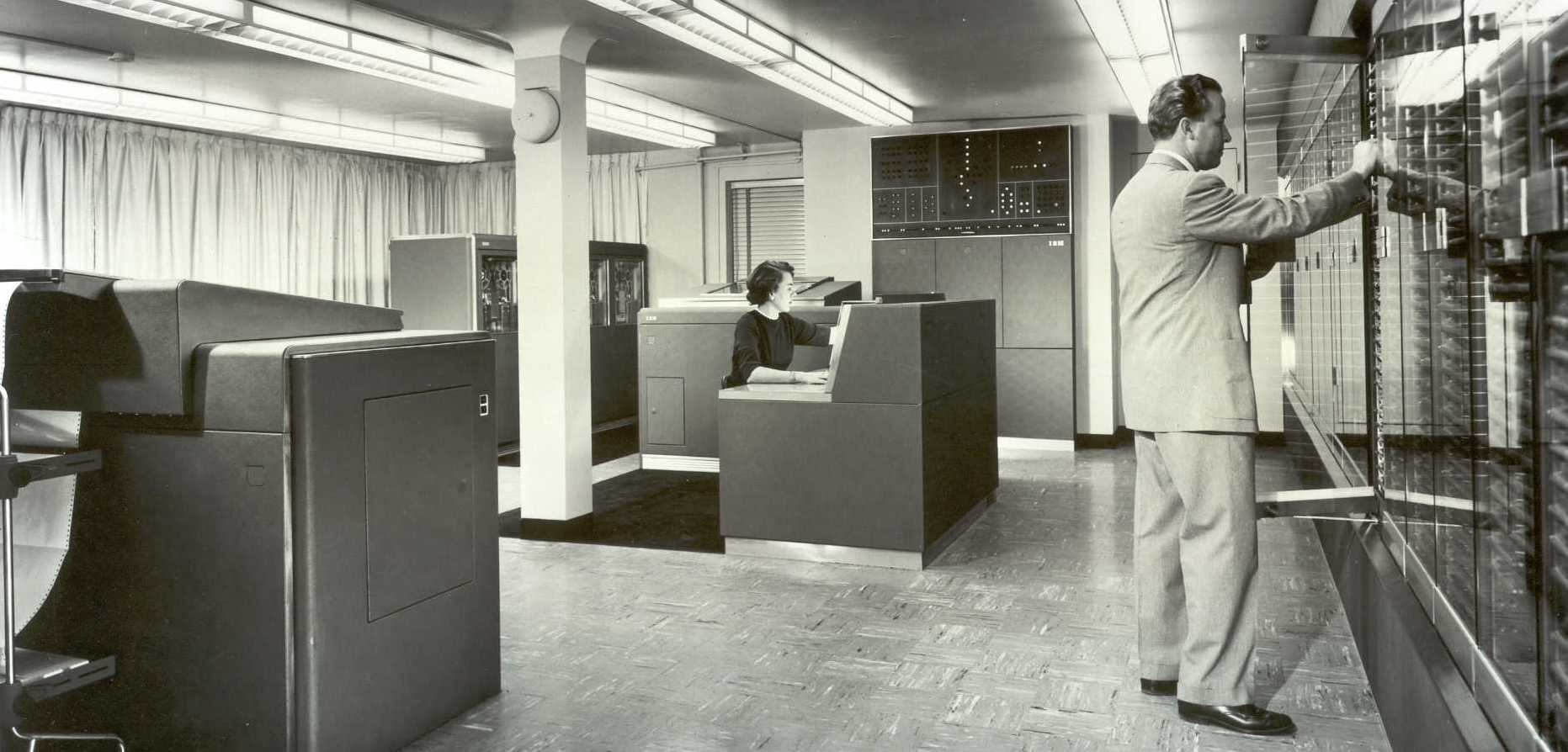
|
| Faith Lillibridge at the NORC console; Byron Havens at right, Columbia University, 1954. |
From J.A.N. Lee's column in the 50th anniversary issue of IEEE Computer:
The Naval Surface Weapons Center at Dahlgren, Virginia, was the primary site of US naval computing, beginning with the 1948 installation of Howard Aiken's Mark II, followed by the Mark III in 1951. The center's next machine, the Naval Ordnance Research Calculator (NORC), was built at the Watson Scientific Computing Laboratory under the direction of Wallace Eckert. Initially, NORC had been scheduled for delivery to the White Oak Naval Facility near Washington, D.C., but the Navy redirected it to the experienced crew at Dahlgren. Physicist Edward Teller had been trying to have it diverted to the Lawrence Livermore National Laboratory, arguing that the lab's nuclear calculations were more important than Dahlgren's ballistic calculations. The Navy won, and NORC was dedicated at Dahlgren on December 2, 1954. John von Neumann, who had just completed work on the IAS machine, was the keynote speaker.
(In fact the dedication was held at Watson Lab; NORC was not moved to Dahlgren until summer 1955 [4].)
NORC DEDICATION

|
| NORC Dedication, Watson Lab, Columbia University, 2 December 1954. Photo contributed by Herb Grosch. |
At the NORC dedication in Watson Lab, 2 December 1954: IBM Chairman Thomas J. Watson, Rear Admiral E.A. Solomons (Executive Office, Secretary of the Navy), Jeannette Watson (Mrs. Watson Senior), Columbia Professor Wallace Eckert, John von Neumann, Captain C.K. Bergin (Director, R&D, Bureau of Ordnance, Dept of the Navy), Rear Admiral C.G. Warfield (Executive Office, Secretary of the Navy) [9,59,61]:
Admiral Solomons had been captain of the destroyer USS Morris, that was in the battles of Coral Sea and Midway and was eventually crippled by a Kamikaze attack off Okinawa. Not shown, but also present: future IBM chairman Thomas J. Watson Junior, Vice-Admiral L.T. Du Bose (who had commanded the heavy cruiser USS Portland at the battle of Midway), Columbia president Grayson Kirk, some other university presidents, Columbia's Ben Wood and Hilleth Thomas, numerous IBM officials, Watson Lab's NORC engineers, 200 other "scientific, business, and military leaders." NORC itself, which calculated π to 3000 digits for the occasion [9,58], is in the background.
NORC was a three-address machine ("multiply A times B and store the result in C"). It was programmed directly in machine language; assemblers came later. Ken King (then a Watson Fellow, i.e. Columbia PhD student at Watson Lab) programmed the demo and corrects the record as follows: "I computed π and e (the base of the natural logarithms) to 1,000,000 places at the dedication of the Norc because John von Neumann wanted to confirm that the digits were random." [65]
Ken Schreiner [61] recalls, "The major honored guests arrived in the morning, and that is when the photos of the 'VIPs' were taken within the confines of the NORC installation. Others (the remainder of the 200 people) came first to the Luncheon at the Men's Faculty Club [on West 117th Street, on the far side of campus]... John von Neumann was the featured speaker. During the hours that followed the luncheon, guests filtered in and out of the NORC room, viewing the machine, receiving demonstrations, and getting answers to questions. Because the whole thing was stretched out in time, I don't believe there were any traffic jams." (In 1954, Columbia had separate Men's and Women's Faculty Clubs; now there is only a Faculty Club.)

|
| Wallace Eckert, Frank Diehl Fackenthal, J. Robert Oppenheimer, Thomas J. Watson, Sr., Columbia Vice President George Pegram (signing guest book), John von Neumann, and I.I. Rabi at the NORC reception at the Men's Faculty Club, December 2, 1954. Photo courtesy Herb Grosch (click for full-size higher-resolution image). |
Ken King recalls [65] that in the six months between NORC's completion and its delivery to Navy, "Dan Tycho and I, as thesis students of LH Thomas, computed the wave functions of the Helium atom on the Norc (Dan Tycho's Ph.D dissertation). This was done under the rubric of testing the machine." Of course Professor Eckert also had access to the machine, and used it to work on the problem of the position of the moon by computing the ephemerides directly from Brown's equations. The task was immense involving some 1,650 trigonometric terms, many of them with variable coefficients, yet the accuracy of the results was so good that in 1965 he was able to correctly show that there was a concentration of mass near the lunar surface (source: O'Connor and Robertson).
In 1958, Eckert said of NORC, "A calculation involving a billion arithmetical operations on large numbers can be completed on the Norc in approximately one day, yet more powerful calculators are foreseen to to meet the ever-increasing demands of science and technology where the solution of a large problem generates even larger problems." [81].
NORC PHOTO GALLERY
Six photos from IBM's December 1954 NORC press kit, plus newspaper clippings and a program, contributed by Ken Schreiner, plus several other images. According to Prof. Eckert, "most of the photographs were taken by Mr. A.W. Hummers" [64]. It is worth noting IBM's use of the word "computer" in its photo captions; this might be the first time IBM used this term (rather than "automatic calculator" or "data processing machine") to denote a stored-program computing device. Click on an image to magnify. Full-size images occupy 100% of the width of your browser, so if you maximize your browser window, you'll get a full-screen image.
| Photo | IBM Caption |
|---|---|
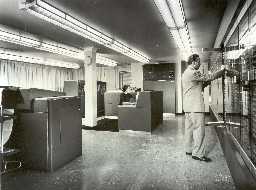
| The Naval Ordnance Research Calculator, built by International Business Machines Corporation for the U.S. Navy, is the most powerful computer in existence. This photo shows NORC's logical and arithmetial unit (right), console (center), magnetic tape units (left, rear), indicator panel (rear) and printer (left, forgeground). |
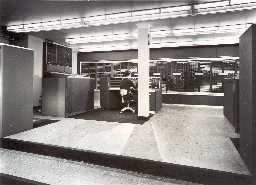
| NORC ... the most powerful large-scale electronic computer ever produced. It was built at Watson Scientific Computing Laboratory, operated by Columbia University. In this photo are pictured the console (center), logical and arithmetical unit (rear), indicator panel (left, rear), printers and tape units (extreme left and right). |
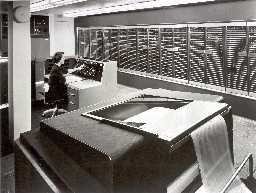
| This view ... shows, in the foreground, one of the two printers used in the installation. Each can print at the rate of 18,000 characters per minute. The printers, which record data without interrupting calculation, give the operator and mathematician a complete picture of the progress of the problem and provide a permanent printed record of results for later study. ... A single operator ... can start and stop the machine and modify the instruction program during calculations. |
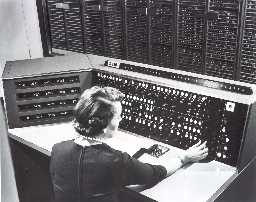
| Shown here is the control console of the NORC. Switches can be used to start and stop the machine and to modify the written program. In normal operation, however, the calculator proceeds automatically according to instructions, recorded on magnetic tape, without control by the eoperator. Any number or instruction in the calculator can be shown on the faces of cathode ray tubes, at left. Selected portions of the program also can be examined in slow motion through this display. |
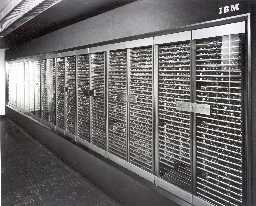
| The completely electronic logical and arithmetical section of the NORC is composed of vacuum tubes, resistors, condensers and crystal rectifiers arranged in circuits. These circuits perform arithmetic and other logical operations and control all parts of the machine. Responsible for the NORC's tremendous speed, this circuitry is the culmination of continued work by scientists and engineers in harnessing the speed of the electron to computing. |
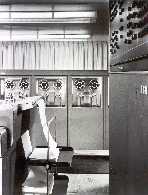
| Operating instructions and program data are read into the NORC from the ultra high-speed magnetic tape units shown here. More than five times faster than the fastest magnetic tape units currently in use, each of eight of these units can read and write more than 70,000 digits per second, a speed equivalent to that of 14,000 typists. In addition to their use for input and ouput, the tapes also store intermediate results during calculations. |
| Other Images | Description |
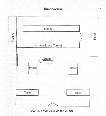
| NORC floor plan, Room 501 Watson Laboratory, Columbia University, 612 West 115th Street, New York City [64]. |

| NORC's memory bank, which is behind the arithmetic and logical unit and therefore out of sight. 3600 66-bit words of memory in 264 Cathode Ray Tubes. Each word represents 16 decimal digits and includes two check bits. Each tube has 900 bit locations; four sets of 66 tubes are employed in the full 3600-word memory. Four tubes are packaged together in a modular metal drawer. Photo and information from [64]. |

| NORC's Tape-to-Card and Card-to-Tape machines. NORC did not have its own card reader or punch; its only input device was tape, and output was only to tape and printer. "The human being does not like to read coded invisible spots, packed 500 to the inch, on a tape a quarter of a mile long." The CTC (Card-Tape-Card) machine converts from cards to tape, and vice versa, allowing NORC to interface with key punches, sorters, collators, and so on. Photo and information from [64]. |
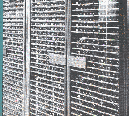
| Closeup of NORC's Arithmetic-Logical Unit, from Reference 2 below. |
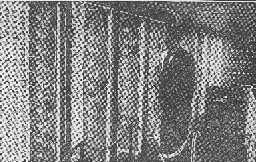
| New York Herald Tribune photo and articles, December 1-3, 1954. |
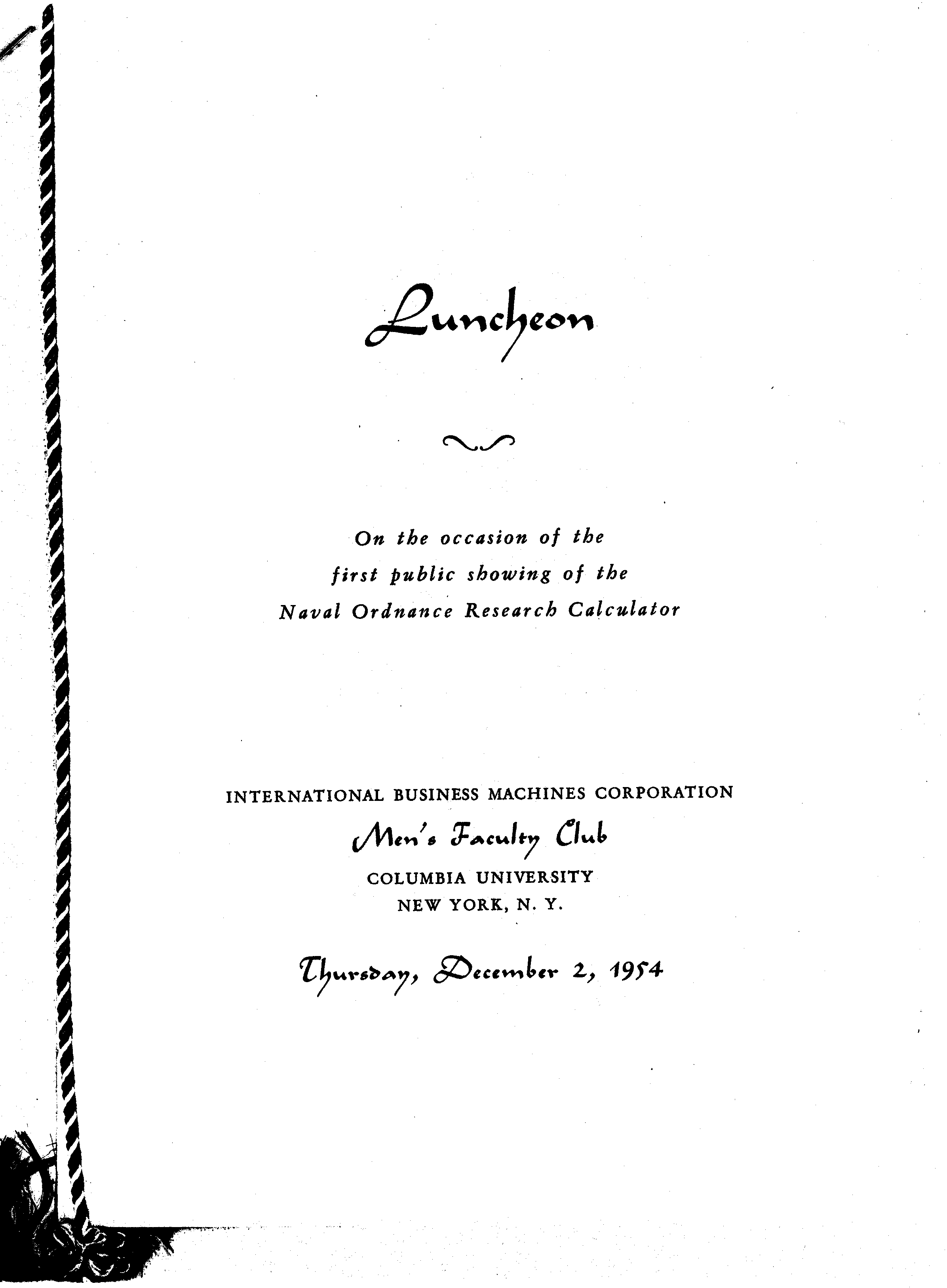
| NORC Dedication Program, December 2, 1954. |
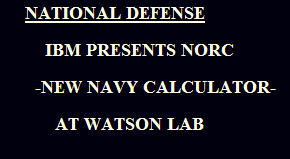
| 1954 IBM newsreel of NORC in action at Watson Lab (offsite). |
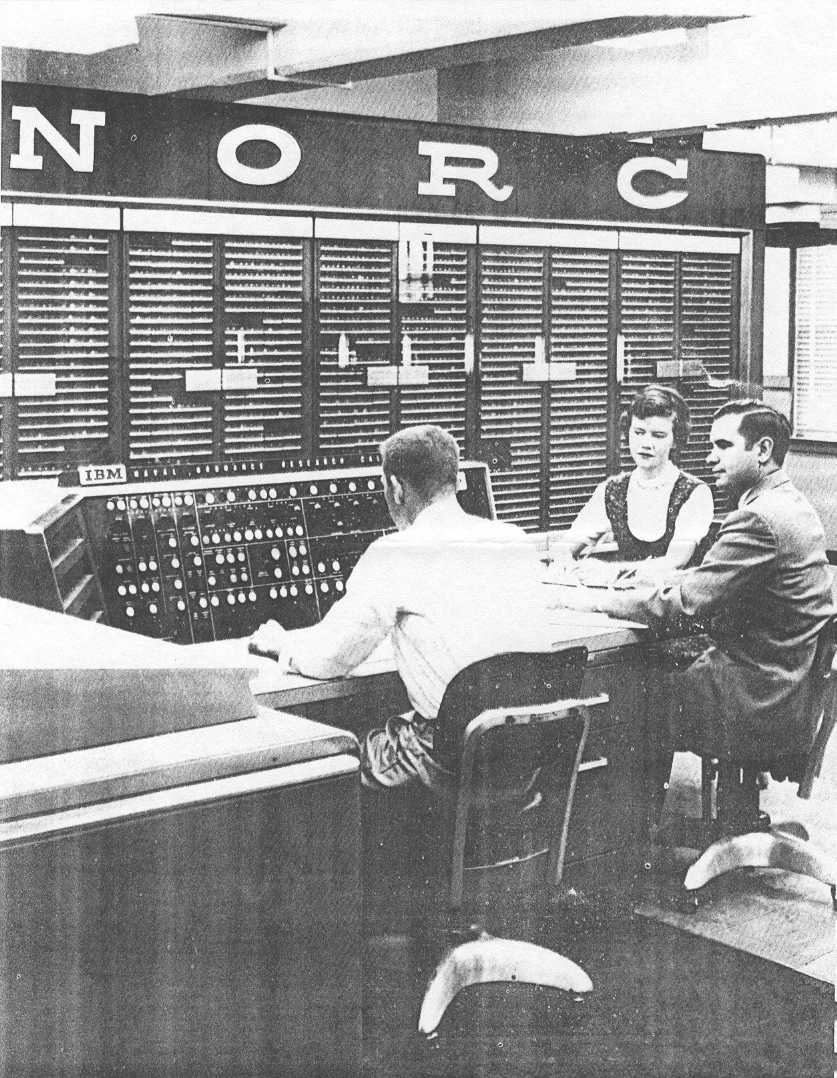
| NORC at the US Naval Proving Ground, Dahlgren, Virginia, about 1957, from Reference 5 below. Console operator unknown; center: Mary Louise McKee, right: Dave Eliezer (Deputy Branch Head, Programming Branch). Ms. McKee was one of the first NORC programmers; she recounts the time she wrote a routine to plot a greeting in Russian on the CRT, only to have the Soviet military visitor try to correct the spelling by taking an eraser to the tube. CLICK HERE for another version of the same photo from a brochure, "Careers in Mathematics", Department of Mathematics, Louisiana State University. |
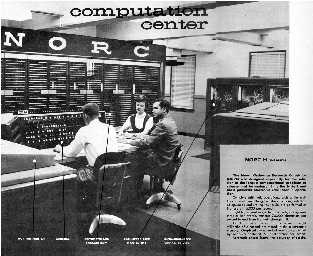
| A higher-resolution version of the previous photo, with labels and a legend. |

| A Happy Birthday cartoon from the NORC shop in Dahlgren,by Jack S. Darling. |

| IBM NORC NWL Digital Logic Unit, from the estate of US Navy Commander Glen Allen Snell. |
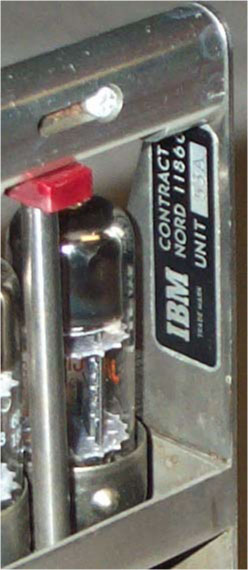
| Closeup of one of the tubes from the Digital Logic Unit. The ID plate identifies the Navy Contract under which the NORC was built as NORD 11866, and identifies the unit as 53A. |
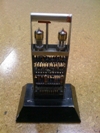
| Another NORC Digital Logic Unit, this one type 46A, presented to Emma Payne McCall of Dahlgren at some point in her tenure there, which spanned the 1950s through the 1970s, submitted by her grandson, Gerhard S. Schoenthal, with a biographical sketch of his grandmother by his mother Rosemary: “Emma Payne McCall, my mother, went to work at the U.S. Naval Weapons Laboratory in the early 1950's. There were very few women in positions other than clerical ones at the time...” |
Notes:
- The first supercomputer in the sense that it was the first whose declared purpose was to surpass all other computers and that there was a significant number of other computers to surpass (thus one would not call ENIAC or ASCC a supercomputer); in Eckert's words, "The aim has been to incorporate in this 'one-of-a-kind' calculator the most advanced developments to produce a calculator particularly suited to the solution of the large complex problems. To this end no effort has been spared to secure extremely high speed, great reliability, and simplicity of operation". Von Neumann named it "the most advanced machine which is possible in the present state of the art." It was not outpaced until the appearance of Seymour Cray's CDC 6600 in 1964, which is also sometimes cited as the "first supercomputer", but 10 years after NORC. It is true, however, that the term "supercomputer" was not coined until some years after NORC, most likely for the Ferranti Atlas or CDC 6600. Nevertheless, various histories list NORC as the first supercomputer (e.g. [57]). Another [40] calls SSEC (also designed at Watson Lab) the first supercomputer.
According to the IBM historical archive, "NORC's fame was extended literally out of this world when astronomer Dr. Paul Herget, Director of the Cincinnati Observatory, arranged to name an asteroid discovered in 1953 for the computer. (The asteroid Norc revolves around the Sun once every 5.6 years in an orbit between Mars and Jupiter.) Under Dr. Herget's direction, and the sponsorship of the Office of Naval Research and the National Science Foundation, the earthbound NORC was used to compute the orbits of celestial bodies, including the most precise orbit of the Earth for the 1920-2000 period. In discussing one of NORC's accomplishments in May 1956, Dr. Herget said: 'We used nine hours of running time and completed more computations than had ever before been done at one time in the history of astronomy.'"
REFERENCES
- Eckert, Wallace J, and Rebecca Jones (PHOTO), Faster, Faster: a simple description of a giant electronic calculator and the problems it solves, McGraw-Hill, New York, 1955 (TITLE PAGE); 160 p. illus. 24 cm. Rebecca (Becky) Jones, an Associate in Astronomy, was Dr. Eckert's Watson Lab assistant and (among other things) Friden calculator wizard, thus a "computer" in her own right [57].
- von Neumann, John, "The NORC and Problems in High-Speed Computing", IEEE Annals of the History of Computing Vol.3 No.3 (July-September 1981), pp.274-279.
- NORC, International Business Machines Corporation, 590 Madison Avenue, New York 22, NY (1954): Form 52-64444-0-20-12-54.
- The Bashe [4] and Pugh [40] books.
- The Grosch book [57].
- US Naval Proving Ground, NORC Programming and Coding Manual (1955), 58pp.
- US Naval Proving Ground, Computation and Analysis Laboratory, Dahlgren, Virginia, approx. 1957.
- Digital Computer Newsletter, Office of Naval Research, Mathematical Sciences Division, Vol.10, No.4, October 1958 [115].
- Explanatory Supplement to the Astronomical Ephemeris and Nautical Almanac, prepared jointly by the Nautical Almanac Offices of the United Kingdom and the United States of America: H.M. Nautical Almanac Office by Order of the Lords Commission of the Admiralty, London, Her Majesty's Stationey Office (1961).
Links (last checked 16 May 2019):
- History expo at Dahlgren's 90th Anniversary (2008)
- The NORC Team (IBM)
- NORC Reference Room (IBM archive, includes brief film clip)
- IBM's NORC (Youtube)
- NORC Programming and Coding Manual, U.S. Naval Proving Ground, Dahlgren, Virginia (undated).
- Dr. John von Neumann at the dedication of the NORC, December 1954, transcript of von Neumann's remarks (in which NORC is misspelled "NORD").
- The Naval Ordnance Research Calculator (University of Manchester Institute of Science and Technology)
- John von Neumann's remarks at the NORC dedication
- Von Neumann versus Watson Sr. (Herb Grosch ACM Lecture, January 2003).
- US Government Computing Collection, CBI 63, 1945-83
- The Williams Tube
Translations of this page courtesy of...
| Language | Link | Date | Translator | Organization |
|---|---|---|---|---|
| Belarusian | Беларуская | 2023/08/21 | Vladyslav Byshuk | Владислав Бишук | studycrumb.com |
| Finnish | Suomi | 2023/08/31 | Kerstin Schmidt | writemyessay4me.org/ |
| French | Français | 2023/08/31 | Kerstin Schmidt | prothesiswriter.com |
| Italian | Italiano | 2023/08/31 | Kerstin Schmidt | admission-writer.com/ |
| Norwegian | Norsk (bokmål) | 2022/08/10 | Rune | Bildeler på nett |
| Polish | Polski | 2023/08/31 | Kerstin Schmidt | justdomyhomework.com |
| Romanian | Română | 2023/08/21 | Vladyslav Byshuk | Владислав Бишук | skyclinic.ua |
| Russian | Русский | 2019/11/22 | Ellie | originalphd.com |
| Spanish | Español | 2023/10/02 | Chema Bescos | Traducciones Sevilla |
| Swedish | Svenska | 2023/08/31 | Kerstin Schmidt | writemypaper4me.org |
| Ukrainian | Українська | 2023/08/21 | Vladyslav Byshuk | Владислав Бишук | studybounty.com |